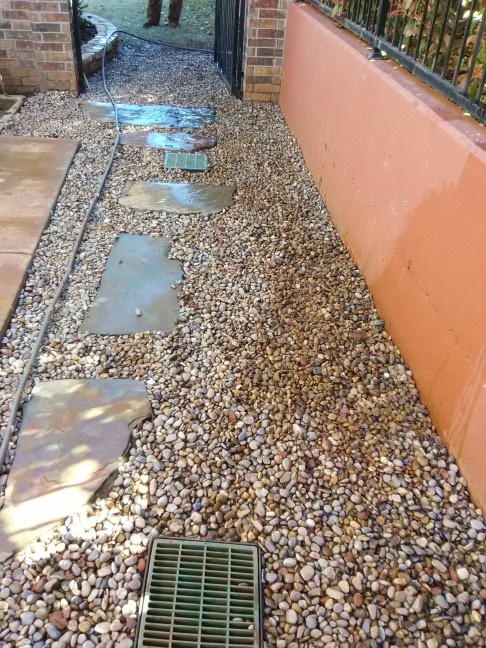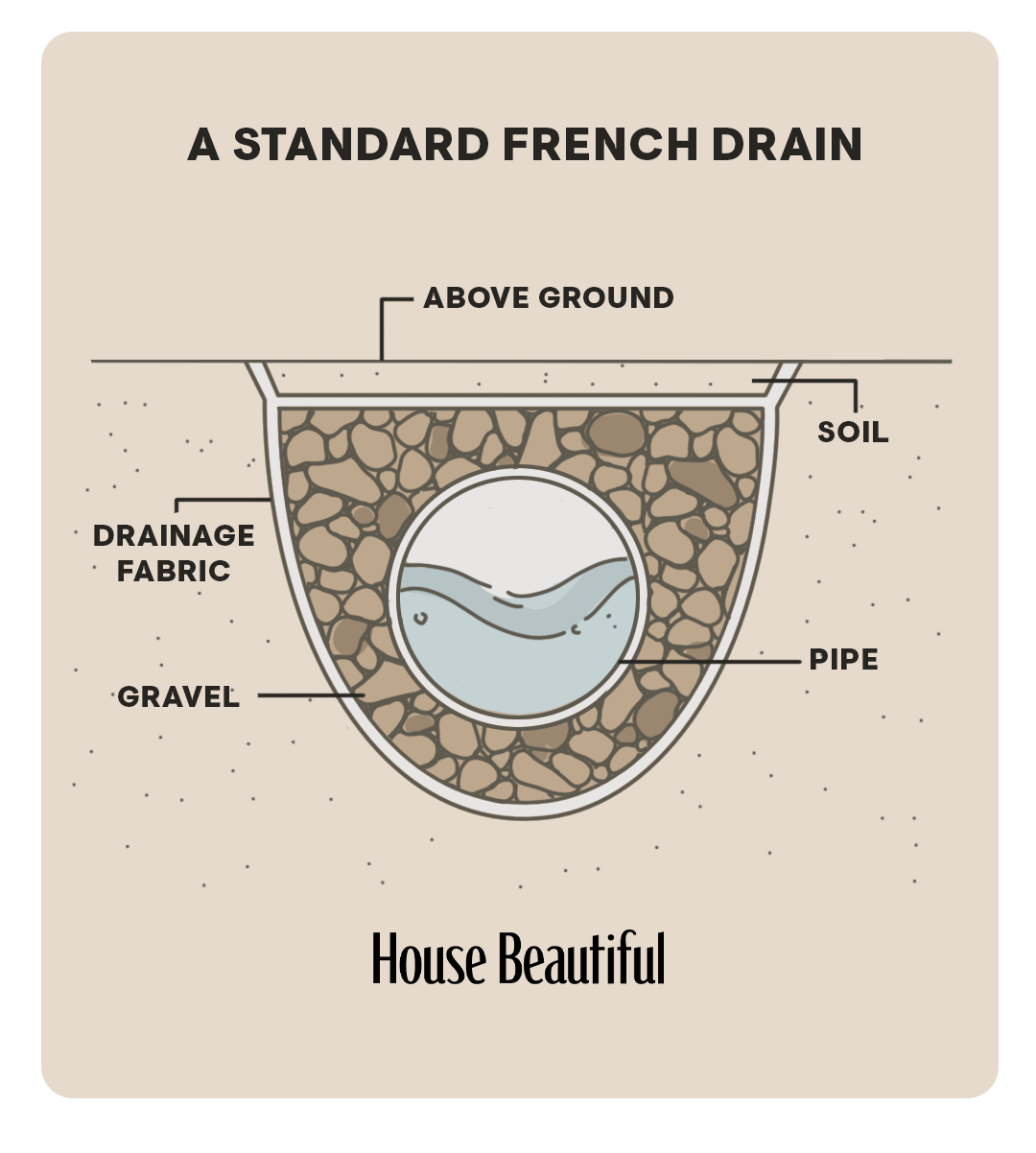The Necessary Overview to Preserving Your French Drain for Long-Lasting Efficiency
Keeping your French drain is vital to its performance and your residential or commercial property's security. Normal checks can conserve you from pricey repair services and water damage. You'll need to know what indicators to try to find and just how typically to check your system. And also, understanding the cleansing procedure can make a substantial difference. Allow's explore the essential actions for guaranteeing your drain works well for several years ahead.
Understanding the Function of a French Drain
A French drain is an essential part in handling water around your home. It guides excess water far from your structure, protecting against flooding and damages. When heavy rain drops, the drain collects water via a perforated pipe hidden in gravel. This system enables water to move openly, minimizing stress on your cellar wall surfaces and decreasing the risk of leaks.You might wonder exactly how it functions in technique. As water saturates the soil, gravity pulls it towards the drain. The perforated pipeline records this water, transporting it to a designated drainage location or tornado sewage system. This procedure keeps your yard completely dry and safeguards your home's architectural integrity.Understanding just how a French drainpipe functions is key to valuing its value. By successfully transporting water away, it helps keep a dry and safe living atmosphere. So, keeping your French drainpipe in leading problem guarantees you prevent pricey repair work down the line.
Regular Inspections: What to Seek
When you're examining your French drain, beginning by checking for any kind of blockages that may be blocking water flow. Focus on indications of surface erosion around the drain, as this can indicate prospective problems. Normal analyses will help maintain your drain system working efficiently.
Clogged Drainpipe Evaluation
How can you tell if your French drainpipe is clogged? Watch for water pooling in your lawn, especially after hefty rainfall. That's a red flag if you notice locations where water gathers instead of draining pipes. You must also examine the drain outlet; if water isn't moving out as it should, there's likely an obstruction. Pay attention for uncommon gurgling audios, which can indicate trapped air. Furthermore, examine the drain's surface for any type of plant life development, as origins can infiltrate and block the system. Finally, if you scent musty odors, it could indicate stagnant water brought on by an obstruction. Consistently evaluating these indications can aid you preserve your French drain efficiently and avoid pricey repair services.
Surface Erosion Inspect

Cleaning Your French Drain: Step-by-Step Guide
Cleansing your French drainpipe is vital for maintaining it working correctly. You'll need some specific devices and a clear process to ensure everything runs smoothly. Allow's walk via the steps and suggestions for preserving your drainpipe successfully.
Devices You'll Need
To tackle the task of cleaning your French drainpipe effectively, you'll want to gather a few vital devices. Initially, get hold of a durable pair of handwear covers to secure your hands from particles and sharp items. A small shovel or trowel will certainly assist you get rid of dirt or blockages around the drainpipe. For cleaning out the interior, a plumber's serpent or a high-pressure water nozzle can be exceptionally valuable. You'll also require a container for accumulating any particles you pull out. Having a yard pipe on hand will make it less complicated to wash out the drainpipe and assure it's streaming efficiently. With these tools all set, you'll be established for a complete cleansing session!
Cleaning Up Process Actions
Begin by evaluating the location around your French drainpipe for any noticeable debris or clogs. Get rid of fallen leaves, branches, or dust that might block water circulation. Next off, inspect the inlet and outlet areas; clear any kind of blockages to guarantee correct drainage. Make use of a garden hose pipe to flush the drainpipe, guiding water into the inlet. This aids remove any type of collected sludge or debris. If you notice persistent clogs, consider utilizing a plumbing professional's serpent to damage them up. After cleaning, examine the crushed rock around the drainpipe; restore it if it's cleaned away. Finally, validate the drain covers are intact and safely in position to prevent particles from entering. Regular cleansing keeps your French drain operating effectively.
Maintenance Regularity Tips
While routine upkeep is vital for your French drainpipe's durability, recognizing exactly how often to maintain it can make all the distinction. Preferably, you need to inspect your French drainpipe a minimum of two times a year, preferably in springtime and autumn. After hefty rains or snowmelt, look for obstructions or particles. If you notice any standing water, it's time to clean your drain.In areas with hefty vegetation, even more frequent maintenance-- about every 3 months-- might be needed. In addition, take into consideration cleansing your French drain after significant tornados or if original site you observe water pooling in your backyard. By staying proactive, you'll assure your French drain functions successfully and secures your property from water damages. Normal checks will save you time and cash in the future.
Determining Common Issues and Their Solutions
It's vital to recognize usual issues with your French drain and carry out effective solutions when you see water merging in your yard or damp places in your basement. One regular trouble is clogging, typically brought on by debris like leaves or debris. To fix this, you can make use of a pipes serpent or a high-pressure water jet to clear blockages.Another issue may be improper incline. Water won't stream away from your home if your drainpipe isn't sloped properly. You can readjust the slope by excavating and rearranging the drainpipe pipe.Lastly, look for damage or splits in the drain itself. If you locate any, changing the damaged sections is very important for peak efficiency. By attending to these problems quickly, you'll assist guarantee that your French drainpipe remains to function effectively, securing your residential or commercial property from water damage and maintaining a dry, safe atmosphere.
Seasonal Maintenance Tips for Your French Drain
Addressing typical problems with your French drainpipe is just the very first step in assuring its lasting efficiency. Seasonal maintenance is vital for peak performance. In the springtime, eliminate leaves and debris that may have collected during winter. Check for any kind of blockages in the outlet or capture container, as water needs a clear path to flow freely.During summer, examine your drainpipe for any indications of changing or working out dirt. Make sure it's still degree and working properly. As loss methods, clear out any fallen leaves to prevent obstructions prior to wintertime arrives.In winter, watch for freezing temperatures. If you live in a cold environment, make sure your drainpipe isn't in danger of freezing. Protecting subjected pipelines can assist. Routine checks and timely upkeep can stop costly repair work and maintain your French drainpipe working successfully year-round. Remain aggressive and delight in peace of mind understanding your drainage system is in good condition!
When to Contact an Expert
When to call in a professional can save you time and prevent further damage to your French drainpipe, recognizing. It's a clear indicator that your drainpipe might be obstructed or harmed if you observe relentless standing water in your yard. Don't disregard odd smells, as they can indicate sewage back-up or degeneration, which needs immediate attention.If you discover that your drain isn't operating appropriately after attempts to clean or preserve it, it's time to reach out click for source for specialist aid. In addition, if you're unsure regarding the underlying problems or lack the required devices, hiring a specialist can give peace of mind.Finally, if your French drainpipe is old or has experienced substantial deterioration, professional assessment can identify whether repairs or full replacement is needed. Depend on the specialists to assure your drain system functions effectively for many years ahead.
Tips for Protecting Against Future Water Drainage Problems
To maintain your French drainpipe functioning successfully, regularly checking and keeping it can make all the difference. Beginning by getting rid of debris, leaves, and dirt from the surface area and drainpipe openings. This stops clogs that can bring about water backup. Inspect the gravel around the drainpipe; if it's compacted or eroded, think about including fresh gravel to maintain suitable flow.Next, draw away water away from additional hints your drainpipe by making certain downspouts and gutters are clear and directing water at least 3 feet away from your foundation. Regularly examine for any type of indicators of damage or drooping. If you observe concerns, resolve them immediately.Finally, think about setting up a filter or a catch basin to trap larger particles prior to it gets in the drain. By staying proactive with these ideas, you'll decrease the threat of future drain issues and maintain your French drain in top form.
Frequently Asked Questions
How Long Does a French Drain Usually Last?
A French drain usually lasts around 30 to 40 years, depending upon the products utilized and maintenance (Portland French Drain). If you keep up with regular checks, you can extend its life-span also better
Can I Mount a French Drainpipe Myself?
Yes, you can install a French drain yourself if you have actually got the right tools and knowledge. Just ensure to prepare thoroughly, follow regional guidelines, and warranty correct water drainage to avoid future problems.
What Materials Are Made Use Of in a French Drain?
You'll need perforated pipeline, crushed rock, landscape fabric, and a strong water drainage pipe for your French drainpipe. These materials aid reroute water efficiently, stopping flooding and keeping your residential property dry and risk-free from water damages.

Is an Authorization Required to Mount a French Drainpipe?
You'll likely require an authorization to set up a French drain, relying on local policies. Get in touch with your municipality to ensure you follow any type of essential standards and avoid prospective concerns throughout installment.
What Are the Prices Related To French Drain Upkeep?
Maintaining a French drain typically sets you back between $100 and $500 every year. You'll need to think about expenses for cleaning, repair work, and inspections. Routine maintenance assists prevent larger costs and guarantees your system works properly for many years - Portland French Drain. When you're evaluating your French drain, begin by checking for any obstructions that might be obstructing water flow. By staying aggressive, you'll guarantee your French drainpipe functions efficiently and shields your property from water damages. When you observe water pooling in your backyard or damp areas in your basement, it's essential to identify common problems with your French drain and apply reliable options. You can readjust the incline by excavating and rearranging the drainpipe pipe.Lastly, check for damage or splits in the drainpipe itself. Examine the crushed rock around the drainpipe; if it's compressed or eroded, take into consideration including fresh gravel to keep optimal flow.Next, draw away water away from your drain by making certain downspouts and gutters are clear and guiding water at the very least 3 feet away from your foundation